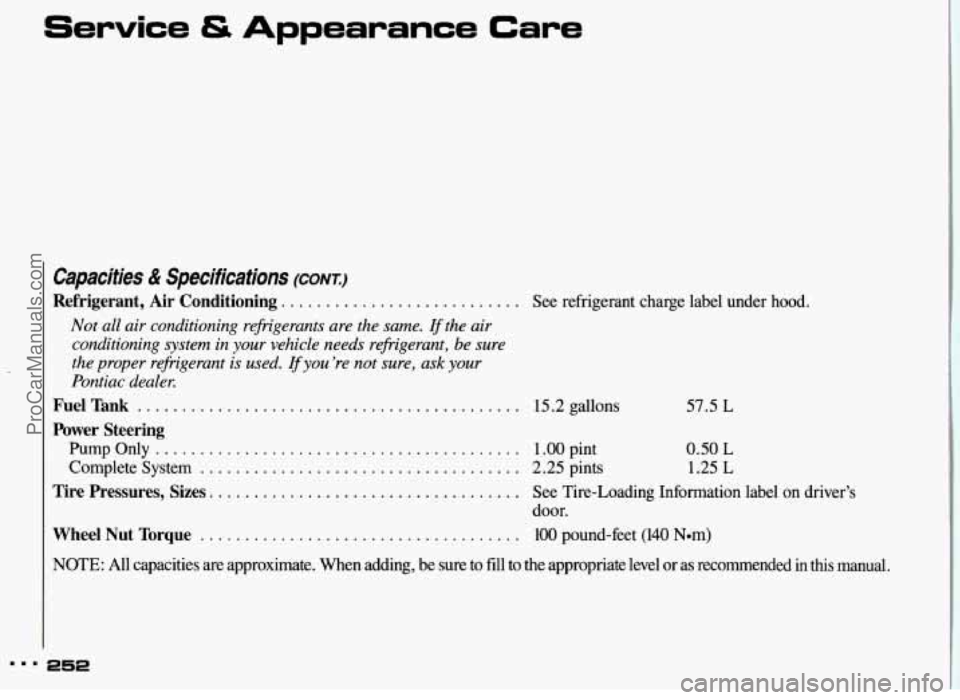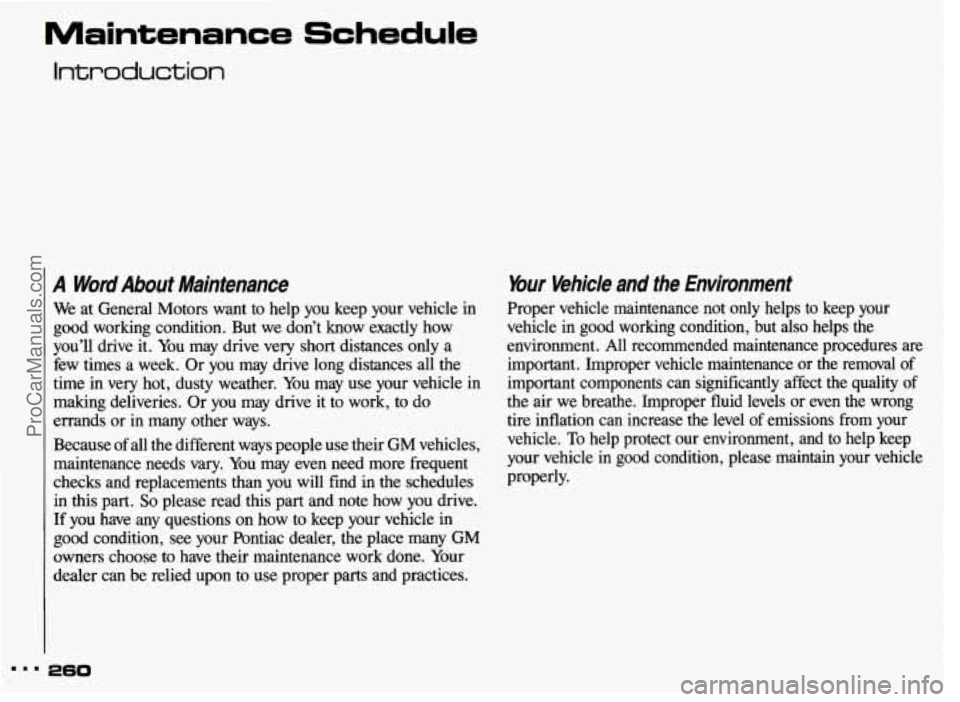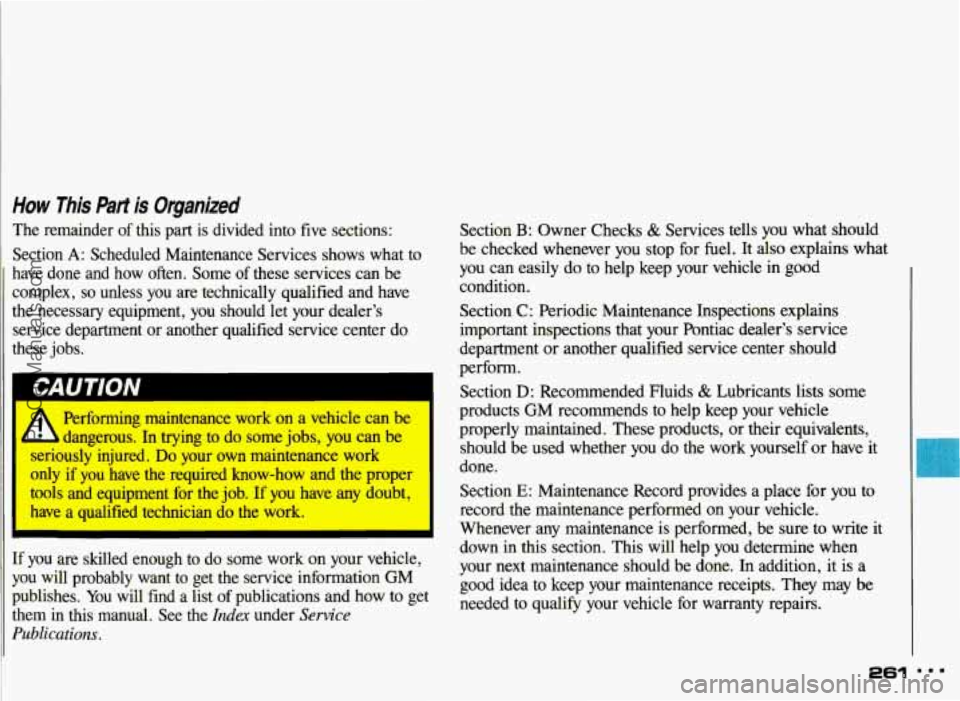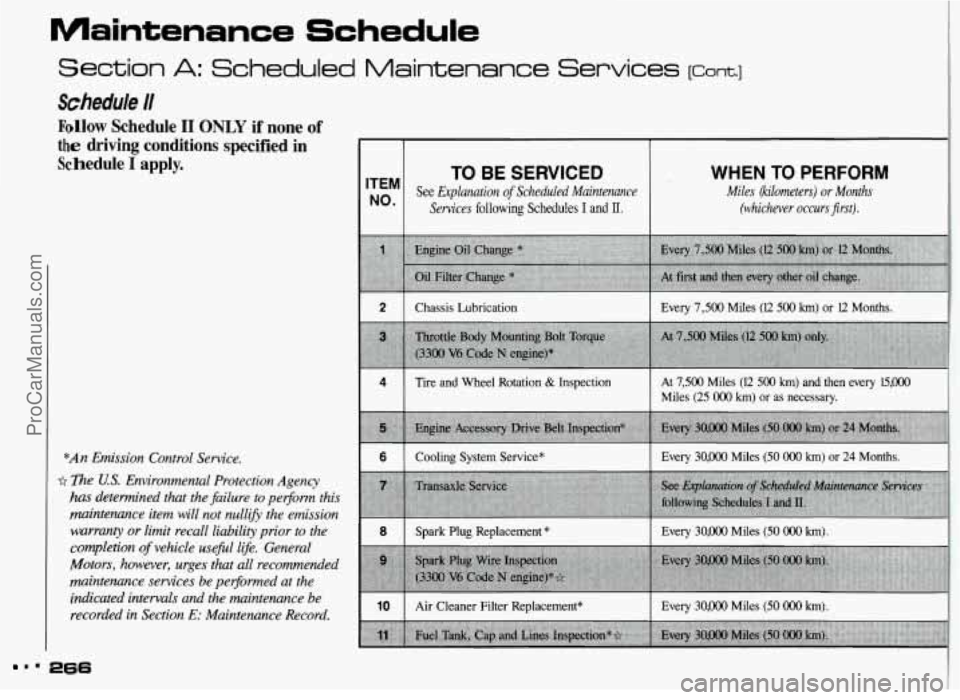1993 PONTIAC GRAND-AM air condition
[x] Cancel search: air conditionPage 238 of 306

Wheel Alignment and
Tire Balance
The wheels on your vehicle were
aligned and balanced carefully at
the
factory to give you the longest tire life
and best overall performance.
In most cases, you will not need to have
your wheels aligned again. However, if
you notice unusual tire wear or your
vehicle pulling one way or the other, the
alignment may need to be reset. If you
notice your vehicle vibrating when
driving on a smooth road, your wheels
may need to be rebalanced.
Wheel Replacement
Replace any wheel that is bent, cracked
or badly rusted. If wheel nuts keep
coming loose, the wheel, wheel bolts,
and wheel nuts should be replaced. If
the wheel leaks air out, replace it
(except some aluminum wheels, which
can sometimes be repaired).
See your
Pontiac dealer if any of these conditions
exist.
Your dealer will know the kind of wheel
you need.
Each new wheel should have the same
load carrying capacity, diameter, width,
offset, and be mounted the same way as
the one it replaces.
If you need to replace any of your
wheels, wheel bolts, or wheel nuts,
replace them
only with new GM
original equipment parts. This way, you
will be sure
to have the right wheel,
wheel bolts, and wheel nuts for your
Pontiac model.
CAUTION I
Using the wrong replacement
I. wheels, wheel bolts, or wheel
nuts
on your vehicle can'be
dangerous.
It could affect the
braking and handling
of your
vehicle, make your tires lose air
and make you lose control. You
could have a collision in which you
or others could be injured. Always
use the correct wheel, wheel bolts,
and wheel nuts for replacement.
237
ProCarManuals.com
Page 247 of 306

Finish Damage
Any stone chips, fractures or deep
scratches in the finish should be
repaired right away. Bare metal will
corrode quickly and may develop into a
major repair expense,
Minor chips and scratches can be
repaired with touch-up materials
available from your dealer or other
service outlets. Larger areas of finish
darnage can be corrected
in your
dealer’s body and paint shop.
Underbody Maintenance
Chemicals used for ice and snow
removal and dust control can collect on
the underbody. If these are not removed,
accelerated corrosion (rust) can occur
on the underbody parts such as fuel
lines, frame, floor pan, and exhaust system even though they have corrosion
protection.
At least every spring, flush these
materials from the underbody with plain
water. Clean any areas where mud and other debris can collect. Dirt packed in
closed areas of the frame should be
loosened before being flushed. Your
dealer or
an underbody vehicle washing
system can do this for you.
Chemical Paint Spotting
Some weather and atmospheric
conditions can create a chemical fallout.
Airborne pollutants can fall upon and
attack painted surfaces on your vehicle.
This damage can take two forms:
blotchy, ringlet-shaped discolorations,
and small irregular dark spots etched into the paint surfhce.
Although no defect in the paint job
causes this, Pontiac will repair, at no
charge to the owner, the surfaces of new
vehicles damaged
by this fallout
condition within
l2 months or l2,OOO
miles (20 OOO km) of purchase,
whichever comes first.
ProCarManuals.com
Page 250 of 306

Fuse Rating Circuitry
Fuse Usage
HORN
ALARM
HTR-A/C
RDO IGN
TURN
DR LK
TAIL LPS
WDO
WIPER ERLS
FTP
ACC
IGN ECM
HDLP
15
15
25
10
20
20
20
30
25
15
20
30
20
20
Back Up Lights, Electronic PRNDL (automatic transaxle)
Fuel Pump, Fuel Injectors
Turn/Hazard/Stop Lights, Anti-Lock Brakes
(ABS), Brake-
Transaxle Shift Interlock
(BTSI)
Power Door Locks, Power Mirrors, Cigar Lighter
BLANK
Instrument Panel Lights
Rear Window Defogger Relay, Chime, Gages,
ABS , BTSI,
Daytime
Running Lights (Dm) (Canada)
Horn
Chime, Interior Lights, Passive Restraints, Radio/Clock Memory
Heater, Air Conditioning, ABS, DRL (Canada), Engine Block
Heater
Radio, Cruise Control, Variable
Effort Steering
Turn Signals
Power Door Locks
Exterior Lights, Fog Lights, Instrument Panel Lights, DRL
(Canada)
Power Windows (Circuit Breaker)
Windshield WipedWasher
Engine Controls, Starter and Charging System
BLANK
Flash-to-Pass
(US.)
Power Seats, Rear Window Defogger (Circuit Breaker)
BLANK
Engine Control Module, Ignition System
BLANK
Headlights, DRL (Canada) (Circuit Breaker)
ProCarManuals.com
Page 253 of 306

Service & Appearance Care
Capacities & Specifications (CONT.:)
Refrigerant, Air Conditioning. .......................... See refrigerant charge label under hood.
Not all air conditioning refrigerants are the same. If the air
conditioning system in
your vehicle needs refngerant, be sure
the proper refrigerant is used.
If you’re not sure, ask your
Pontiac dealer.
Fuel Tank ......................................... 15.2 gallons 57.5 L
Power Steering
Pump Only ......................................... 1 .OO pint 0.50 L
Complete System .................................... 2.25 pints 1.25 L
Tire Pressures, Sizes. .................................. See Tire-Loading Information label on driver’s
Wheel Nut Torque .................................... 100 pound-feet (140 Nom)
door.
NOTE: All capacities are approximate. When adding, be sure to fill to the appropriate l\
evel or as recommended in
this manual.
... 252
ProCarManuals.com
Page 261 of 306

Maintenance Schedule
Introduction
A Word About Maintenance
We at General Motors want to help you keep your vehicle in
good working condition. But we don’t know exactly how
you’ll drive
it. You may drive very short distances only a
few times a week. Or you may drive long distances all the
time in very hot, dusty weather. You may use your vehicle in
making deliveries. Or you may drive it to work, to do
errands or
in many other ways.
Because of all the different ways people use their GM vehicles,
maintenance needs vary. You may even need more frequent
checks and replacements than you will find in the schedules
in this part. So please read this part and note how you drive.
If you have any questions on how to keep your vehicle in
good condition, see your Pontiac dealer, the place many GM
owners choose to have their maintenance work done. Your
dealer can
be relied upon to use proper parts and practices.
Your Vehicle and the Environment
Proper vehicle maintenance not only helps to keep your
vehicle in good working condition, but also helps the environment. All recommended maintenance procedures are
important. Improper vehicle maintenance or the removal of
important components can significantly affect the quality of
the air we breathe. Improper fluid levels
or even the wrong
tire inflation can increase the level of emissions from your
vehicle.
To help protect our environment, and to help keep
your vehicle in good condition, please maintain your vehicle
properly.
ProCarManuals.com
Page 262 of 306

How This Part is Organized
The remainder of this part is divided into five sections:
Section
A: Scheduled Maintenance Services shows what to
have done and how often. Some of these services can be
complex,
so unless you are technically qualified and have
the necessary equipment, you should let your dealer's
service department or another qualified service center do
these jobs.
Performing maintenance work on a vehicle can be
3 dangerous. In trying to do some jobs, you can be
.-' wsly injured. Do your own maintenance work
UIUY if you have the required know-how and the proper
tools and equipment for the job. If
you have any doubt,
have a qualified technician do the work.
I
If you are skilled enough to do some work on your vehicle,
you will probably want to get the service information GM
publishes. You will find a list
of publications and how to get
them in this manual. See the
Index under Service
Publications.
Section B: Owner Checks & Services tells you what should
be checked whenever you stop for fuel. It
also explains what
you can easily do to help keep your vehicle in good
condition.
Section
C: Periodic Maintenance Inspections explains
important inspections that your Pontiac dealer's service
department or another qualified service center should
perform.
Section
D: Recommended Fluids & Lubricants lists some
products GM recommends to help keep your vehicle
properly maintained. These products, or their equivalents,
should be used whether you do the work yourself or have it
done.
Section
E: Maintenance Record provides a place for you to
record the maintenance performed on your vehicle.
Whenever any maintenance is performed, be sure to write it
down in this section. This will help you determine when
your next maintenance should be done. In addition, it is a
good idea to keep your maintenance receipts. They may
be
needed to qualify your vehicle for warranty repairs.
ProCarManuals.com
Page 267 of 306

Maintenance Schedule
Section A: Scheduled Maintenance Services lcont.1
Schedule I1
Follow Schedule I1 ONLY if none of
the driving conditions specified in
Schedule
I apply.
*An Emission Control Sewice.
fi The US. Environmental Protection Agency
has determined that the failure to per$orm this
maintenance item
will not nullifL the emission
warranty or limit recall liability prior to the
completion
of vehicle usefil life. General
Motors, however, urges that
all recommended
maintenance services be per$ormed at the
indicated intervals and the maintenance be recorded in Section
E: Maintenance Record.
TO BE SERVICED
See &planation of Scheduled Maintenance
Services following Schedules I and II.
ITEM
No'
WHEN TO PERFORM
Miles (kilometers) or Months
(whichever occurs first).
2 I Chassis Lubrication 1 Every 7,500 Miles (E 500 km) or 12 Months.
Tire and Wheel Rotation
& Inspection At 7,500 Miles (12 500 km) and then every l5,000
Miles (25 000 km) or as necessary.
6 I Cooling System Service* I Every 30,000 Miles (50 000 km) or 24 Months.
8 I Spark Plug Replacement * I Every 30,000 Miles (50 000 km).
10 I Air Cleaner Filter Replacement* I Every 30,000 Miles (50 000 lan).
' 266
ProCarManuals.com
Page 270 of 306

ITEM
NO. SERVICE
5 Engine Accessory Drive Belt Inspection*-
Inspect the belt. for cracks, fraying, wear and
proper tension. Replace
as needed.
6 Cooling System Service*-Drain, flush and refill
the system with new or approved recycled coolant
conforming to
GM Specification 1825M. Keep
coolant at the proper mixture as specified. See the
Index under Coolant. This provides proper freeze
protection, corrosion inhibitor level and engine
operating temperature.
Inspect hoses and replace if they are cracked,
swollen or deteriorated. Clean the outside of the
surge
tank and air conditioning condenser.
To help ensure proper operation, we recommend a
pressure test
of both the cooling system and the
surge
tank pressure cap.
doesn’t require changing.
7 Transaxle Service-For a manual transaxle, fluid
ITEM
NO. SERVICE
For an automatic transaxle, change both the fluid
and filter every
15,000 miles (25 OOO krn) if the
vehicle is mainly driven under one or more
of these
conditions:
In heavy city traffic where the outside temperature
regularly reaches 90°F
(32OC) or higher.
In hilly or mountainous terrain.
When doing frequent trailer towing. With some
models, you shouldn’t even tow a trailer. See the
Index under Towing a Trailer.
Uses such as found in taxi, police car or delivery
service.
8
9
If you do not use your vehicle under any of
these conditions, change both the fluid and filter
every 100,000 miles
(160 000 km).
Spark Plug Replacement *-Replace spark plugs
with the proper type. See the
Index under
Replacement Parts.
Spark Plug Wire Inspection (3300 V6 Code N
engine)**-Inspect for burns, cracks or other
damage. Check the boot fit at the coils and at the
spark plugs, Replace wires as needed.
ProCarManuals.com